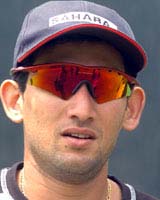He started off his career for Bombay (now Mumbai) as an all-rounder. He was an explosive batsman, and would bowl with a very good pace too. As a matter of fact, his performances in the domestic first class matches as an all-rounder must have earned him a place in the national side, rather than his bowling skills alone.
When he did his debut in the year 1998, it raised a few eyebrows- his was a frail figure which underwent the physically demanding task of fast bowling.
"Put on weight or quit fast bowling," was the advice offered to him by the great Sunil Gavaskar. In my opinion, he has done neither of these two things. He has continued to bowl at a decent pace for an Indian player, without dropping any speed, with almost the same body weight.
The reason I described Ajit Agarkar as a strange kind of player will become clear as I write further.

His debut and a score of matches thereafter were memorable. A good fiery, consistent spell would allow pick up quite a few wickets during those days. In no time he was known to the world, for he broke the record set by Dennis Lillee, another great fast bowler. He claimed his 50th ODI wicket in 23 matches: Dennis Lillee had taken 24 matches to claim his name on the record.
Ajit's remarkable performance continued, but as time passed by, his batting skills started to diminish. In India's 1999-2000 tour Down Under, Agarkar 'scored' five ducks in successive innings before getting his highest score of 19 in the series. This dubious feat earned him his new nick-name - The Bombay Duck.
He did come back stronger however. In Australia's 2003 visit to India, he brought about impressive performances, which underlined his ability to learn, adapt and strike back.
In India's tour to England in 2002, Ajit's batting skills were revived. In the very first Test, India were asked to get 568 to win in the second innings. With the scoreline at dire straits of 6-170, Agarkar rose to the occasion. In most of the cases, it would have been his duty to stay with VVS Laxman, the only top order batsman remaining and help him save the test. In this case, instead, the Duck decided to call his own shots. Batting at no. 8, he scored his maiden test century. And what a venue he chose to do that!
His bowling and batting underwent many ups and downs as the seasons passed by. In 2003-04 tour to Australia, he played a very important part. In the Adelaide test, his 6-42 helped India set itself a modest target of 232, which it accomplished. His remarkable dismissals of Justin Langer (LBW) and Michael Katich (short ball-caught at fine leg) would still be fresh in the fans' memories.
Talking of his explosive batting style, one can't forget his heroics against the-then strong Zimbabwe side. He holds the record for fastest fifty (in 21 deliveries) by an Indian in an ODI. On a couple of occasions his late fireworks have helped India post a big score.
He has been criticized for his very high runs-per-over stats. In the ODI's where containing the score can be at best equally critical as getting wickets, his inconsistency in hitting the correct line has resulted in giving more than five runs an over. Especially in the 'death' overs, at times his bowling has turned out to be a liability for the captain.
More recently, in the dismal tour to the West Indies, he was the bowler rejuvenated. He had done his homework and it showed in his tight line and length throughout the series. If one wanted to take some positives from the 4-1 drubbing, it was Ajit Agarkar's return to form. In most surprising circumstances, he was dropped from the test side, and had to return home.
In the most recent, and most forgettable tours of the recent times, in South Africa, Ajit's bowling seemed to have lost the touch again. He was taken for a simple ride by the batsmen, and the extra-ordinary bounce not only surprised the Indian batsmen, but caused controllability problems for the bowlers as well.
Ajit keeps springing surprises one after the other. Be his century in losing cause at Lord's or his memorable five-for at Adelaide, one can't help but speculate: when is the next one coming?
It came in India's maiden venture into Twenty-20 international, a further reduced form of One Day cricket. Ajit, brought in as the first change, claimed a wicked on his first ball. The 15 balls he sent down, he claimed two wickets and gave away only 10 runs: a commendable feat considering the nature of the game. And after achieving this, he injured his calf muscle, and is expected to be out of international cricket at least for the next three weeks!
He may have taken fastest fifty wickets, he may have scored fastest fifty runs among any Indian batsmen; yet nobody calls him a real threat. He may have bowled for the cause of Indian victory in long years Down Under, or he may have his maiden century at the Lord's, does it really count? He may have gone for over five to six runs per over, yet he may have come back strongly in recent years, yet there is something that's lacking.
I can't quite analyze what exactly it is that is lacking, yet I feel something must be there. Otherwise, why would the world call him The Bombay Duck, when he has got so many impressive performances throughout his career?
Well, a semi-colon to all that debate for now. Today, December 4th is his birthday, so let's just wish the Duck the very best on his birthday. May he find out what exactly is lacking, and we will see...
No comments:
Post a Comment